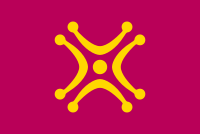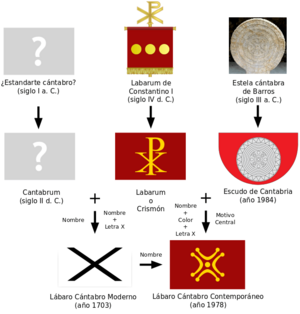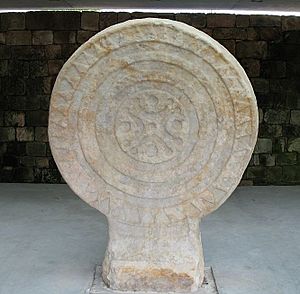Cantabrian labarum facts for kids
 |
|
| Name | Lábaru |
|---|---|
| Use | Civil and state flag |
| Proportion | Not defined |
| Adopted | March 15, 2016 |
| Design | Purple cloth on which there is what would be called in heraldry a "saltire voided" made up of curved lines, with knobs at the end of each line. |
The Cantabrian labarum (called lábaru cántabru in Cantabria) is a modern symbol. It looks like an old military flag from ancient times. The Romans called this ancient flag the Cantabrum.
The labarum is a purple flag. It has a special design in the middle. This design looks like an "X" made of curved lines. Each line has a round knob at its end.
The name and design of this flag come from an idea. This idea connects the ancient Roman Cantabrum flag with another Roman flag called the Labarum. Some people think they are the same symbol. The Labarum was a Roman flag that later had a Christian cross on it.
The word "labarum" itself has old roots. It comes from an ancient word meaning "to speak." This word is found in many Celtic languages. For example, in Welsh, llafar means "speech" or "language."
Why is the Cantabrian Labarum Important Today?
The Cantabrian labarum is a very important symbol for the people of Cantabria. It represents their identity and values.
On March 14, 2016, the Parliament of Cantabria held a meeting. The Parliament is like the government's main decision-making body. They officially recognized the labarum.
Here is what the Parliament decided:
- They recognized the labarum as a symbol of the Cantabrian people. It shows who they are and what they believe in.
- They asked all groups in Cantabria to help share knowledge about the labarum. They want everyone to know it as a symbol of Cantabrian identity.
- They also made sure that the official flag of Cantabria and other symbols still keep their important status.
This decision means the Cantabrian labarum is now an officially recognized symbol. It helps people connect with their history and culture.
See also
 In Spanish: Lábaro cántabro para niños
In Spanish: Lábaro cántabro para niños
- Labarum
- Lauburu
- Fasces
- Labrys
- Christian symbolism
- Christogram



